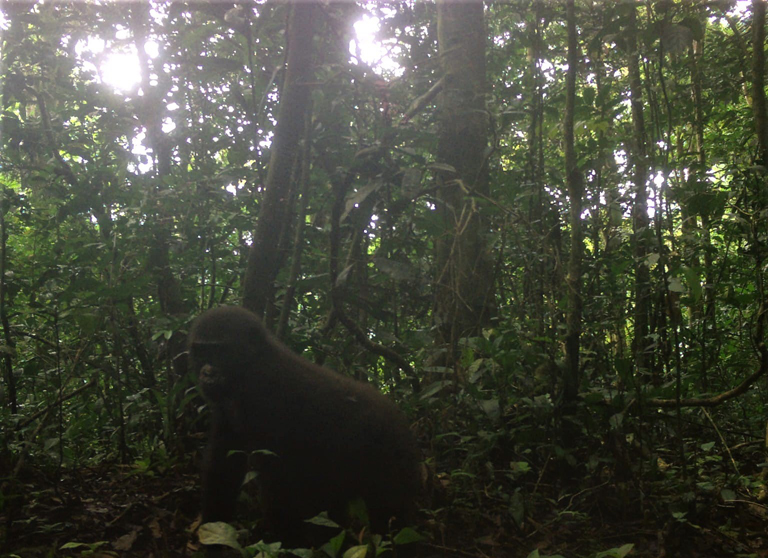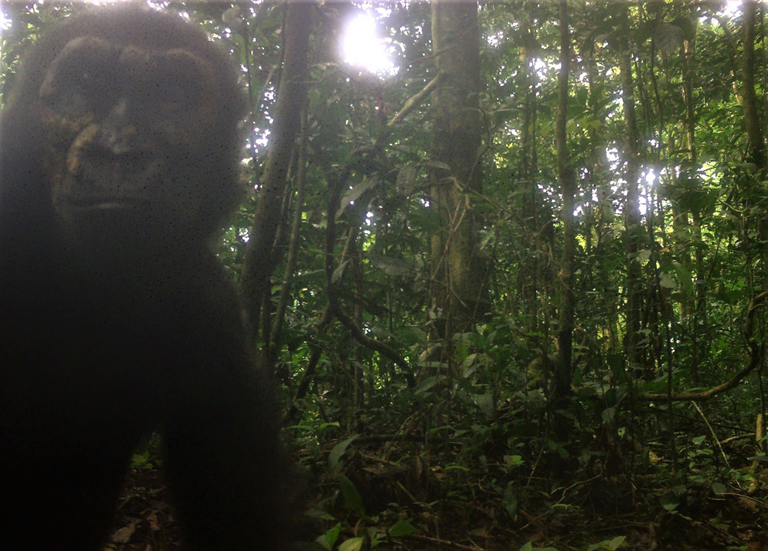Images of wild western lowland gorillas have been captured by camera traps deep in the jungles of central mainland Equatorial Guinea, marking the first time that the region’s gorillas have been caught on film in more than a decade.
Camera traps deployed by conservationists with the Bristol Zoological Society (BZS) and the University of West of England (UWE) took the photos in Monte Alén National Park, which is located in central Rio Muni, the mainland region of Equatorial Guinea. (The Central African country also includes the Bioko Islands in the Gulf of Guinea and the island of Annobón south of the equator.) Local communities had reported gorilla sightings in the region, but conservationists hadn’t seen the animals for themselves until now.
Dr. Gráinne McCabe, who heads up the Conservation and Field Science program at BZS, said that the rarity of gorilla sightings by conservationists working in the park might suggest that their numbers there are low. It has been more than 10 years since researchers last worked in the area, McCabe added. The images of gorillas in Monte Alén National Park were captured as part of a partnership between BZS, UWE, and conservation NGO The Biodiversity Initiative that seeks to create an inventory of Equatorial Guinea’s wildlife.
“We were so excited when we saw the images. One of our assistants let out a shout when he opened the first photo of the gorilla,” McCabe said in a statement. “To see these animals in real life would be magical, but this is the next best thing, and so this is truly special — certainly a career highlight.”
Particularly exciting, McCabe noted, is the fact that young gorillas estimated to be about four years old can be seen in the photos. In other words, there is a new generation of Equatorial Guinea’s western lowland gorilla population and it appears to be doing well.
The western lowland gorilla (Gorilla gorilla gorilla) is one of two recognized subspecies of the Western Gorilla (Gorilla gorilla), with the other subspecies being the cross river gorilla (Gorilla gorilla diehli). The western lowland gorilla population in Monte Alén National Park is considered to be of particular importance to the survival of the species, which is listed as Critically Endangered on the IUCN Red List. Western lowland gorillas can be found in almost all protected areas and many logging concessions across their range, which also includes Angola, Cameroon, Central African Republic, Gabon, and the Republic of Congo.
The number of western lowland gorillas declined by nearly 20% between 2005 and 2013, according to the IUCN. It was estimated that there were a little over 360,000 individuals remaining as of 2013, but their numbers kept dropping, reaching an estimated 316,000 individuals by the end of 2018. The number of gorillas presents today is not known due to the fact that they live in some of the densest and most remote rainforests in Africa.
Poaching is seen as the main threat to the gorillas, primarily hunting for bushmeat — a threat that has been exacerbated by the intrusion of logging operations throughout the animals’ range.
“Until the mid-1990s, much of the Western Lowland Gorilla’s range included vast, roadless blocks of forest that were extremely difficult to access, where human population densities were very low and Gorilla densities high,” the IUCN reports. “In the last quarter century, however, almost all unprotected terra firma forest in this region has been allocated as logging concessions. This means that much of the once-remote, inaccessible forest is now covered by a network of logging roads, which gives easy access to both hunters entering the forest and traffickers.”
McCabe said that a number of other primates, including mandrills and various species of smaller-bodied monkeys, are also hunted in central Rio Muni for bushmeat, as the meat is considered a delicacy in the cities of Central Africa.
Photographing gorillas in Monte Alén National Park is significant because it confirms their continued existence despite heavy hunting pressure, McCabe said: “Levels of poaching in the park are very high and so we have always been very concerned that they are at risk of being hunted into extinction in this area.”
The photos of the gorillas will also help to establish a conservation plan for the park. “We will be able to work alongside the national park to find areas where patrols should be targeted to prevent poaching, for example,” McCabe said. “Eventually, if poaching can be controlled, we may be able to help bring back eco-tourism to the area.”
A field team with BZS is currently setting up more camera traps in Equatorial Guinea, with 30 cameras expected to be in place in the national park by early April in order to gather more data on the gorilla population and distribution.
Dr. David Fernández, a primate behavioral ecologist and conservation biologist at UWE who co-leads the Equatorial Guinea wildlife cataloguing project with McCabe, said that the camera trap data will be used to determine the gorilla population’s size and location across the park. “We will use this information to establish how best we can work with the national park authorities in the area.”
Original story at Mongobay.com


